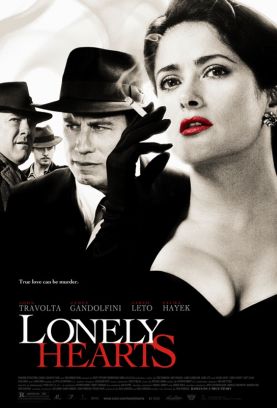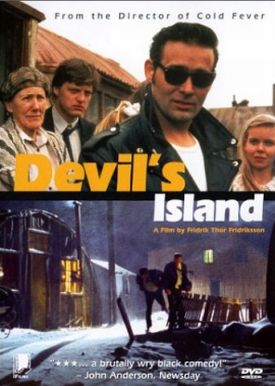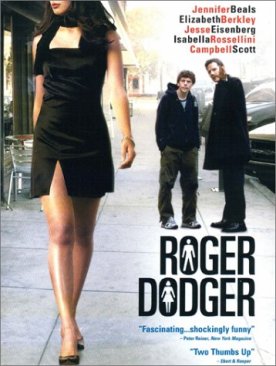Lonely Hearts
The most gruesome moment of Todd Robinson’s gruesome film Lonely Hearts doesn’t make it onto the screen. This is a bit of a surprise. From its opening credits — over still photos of murder victims in 1940s-style clothes and Police Gazette-style photos lying where they fell, in pools of their own blood — to its final, graphic depiction of execution by electrocution, the movie is not otherwise characterized by reticence. Most memorable to some, perhaps, will be a scene featuring what may turn out to be a classic splatter shot as a naked woman sitting astride a man is shot in the back of the head, so that her blood sprays over her partner. There seems not to be much, in other words, that Mr Robinson is likely to stick at. Yet at his film’s climax, the hero, Detective Elmer C., “Buster,” Robinson (John Travolta), gingerly lifts the lid of a wooden crate that recently contained a child’s tricycle and peeps inside. Instead of seeing what he sees, we see him moan, close the lid and stagger away to be sick.
Why the sudden access of delicacy? You’ll be able to work it out, I think, if you see the film — which I don’t recommend. But its drawing back at this point suggests that, at some level, the director must still be capable of feeling shame for the prurience of his camera in seeking out so many and so vivid images of violent death. Like other films with the same interests — last year’s Black Dahlia and Hollywoodland come to mind — it covers its salacious itch with a period setting. The noir-era ambiance is to violence-porn what the jungles of Africa used to be to naked flesh: an excuse to show what would look outré in any other setting.
And, like those earlier films, Lonely Hearts gets an extra kick from being based on real events. The so-called “Lonely Hearts killers,” Raymond Fernandez and Martha Beck (here played by Jared Leto and Salma Hayek) met lonely war widows through personal ads. Raymond would romance them, promise them marriage, steal their life savings and then murder them. Martha was originally one of Raymond’s victims until he genuinely fell for her and allowed her to join in the scam, representing herself as his sister. By all accounts, including this one, she was the more vicious of the two. Together they may have killed as many as 20 women. They were tried, convicted and executed at Sing Sing in 1951.
Mr Leto and Miss Hayek naturally go to town with the lovers’ twisted psyches and their amour fou, showing while they are allowed on screen why (and how) their story has been made into movies at least twice before — as The Honeymoon Killers in 1970 and in a Mexican version, Deep Crimson (Profundo Carmesí), in 1996. But Mr Robinson’s excuse for revisiting the subject is that Buster Robinson, who with partner Charlie Hildebrandt (James Gandolfini) eventually caught the killers, was his grandfather. That may be why he spends so much of his time on the detective rather than his detection. For if the story of the killers’ pursuit and capture is an exciting one, you wouldn’t know it from this film. Buster’s detective work does get a certain amount of attention but not nearly so much as his private life, shown in parallel with the criminal career of the killers.
Buster, you see, is a lonely heart too. His late wife committed suicide for unknown reasons, leaving both Buster and their son, Eddie (Dan Byrd), heart-broken. Now Eddie is acting out — as they wouldn’t have said in the 1940s — and Buster is riding him pretty hard while trying to conceal an unofficial sexual relationship with Rene (Laura Dern), who works at the station. It’s a pity to see so fine an actress as Miss Dern with so little to do. There’s no real story in the part of the film devoted to the detective’s home life. Instead, there are what amount to repeated establishing shots of his pain and loneliness — which I guess have to stand in for the pain and loneliness of the killers’ widow-victims, since none of them is a fully-realized character.
This is the worst mistake made by the younger Mr Robinson — who has made TV movies and documentaries but no previous feature. Maybe it’s his taste for gore which makes him want to keep us from knowing too much and therefore caring too much about the victims. Or maybe he’s trying to convey how desensitized Buster has become to others’ pain by dwelling so much on his own. But either way he has taken out of the material most of what could have lent it moral and dramatic force. All we’re left with is Buster’s sensitivity, the wise-cracking cross-talk between the cops, the sicko killers’ obsession with each other and, well, the blood. I don’t know about you, but that’s not enough for me.
Discover more from James Bowman
Subscribe to get the latest posts to your email.






